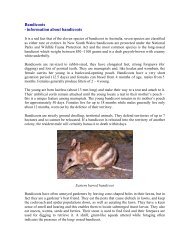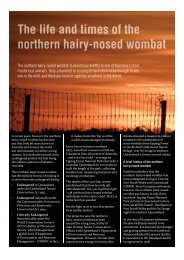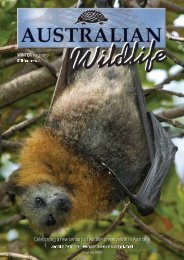Wildlife Preservation Autumn 2012.indd - Wildlife Protection Society ...
Wildlife Preservation Autumn 2012.indd - Wildlife Protection Society ...
Wildlife Preservation Autumn 2012.indd - Wildlife Protection Society ...
Create successful ePaper yourself
Turn your PDF publications into a flip-book with our unique Google optimized e-Paper software.
Blue sun orchid (Thelymitra sp.). This incredibly stunning orchid species is often found in great<br />
numbers in random locations all through the Little Desert National Park<br />
Western blue-tongued lizard (Tiliqua occipitalis). Although rarely encountered, if found, their beautiful<br />
markings are very obvious and clearly identifiable<br />
as correa (Correa spp.) that blanket<br />
the understorey of the heathland.<br />
Delicate grevillea (Grevillea spp.)<br />
owers erupt amongst their<br />
sharp, menacing leaves along with<br />
eremophila (Eremophila spp.) and<br />
the rst emergence of native orchids<br />
combine to make the winter season an<br />
unexpected delight.<br />
Walking along the various paths in<br />
the winter is a great way to stay warm<br />
and the fresh perfumes of the damp<br />
mallee habitats will delight your<br />
senses. Small bush birds that remain<br />
throughout the winter visit the tiny<br />
owers, gathering nectar and insects,<br />
as they too struggle to keep warm<br />
during this challenging time.<br />
Other animals that you may not<br />
necessarily see, but you will de nitely<br />
hear, are the frogs. The many calls<br />
resonating from springs, dams and<br />
lakes echo great distances in an attempt<br />
to attract the attention of females for<br />
reproduction. The region is home to<br />
many species of frog, but in particular<br />
two species of burrowing frog: the<br />
Mallee spadefoot toad (Neobatrachus<br />
pictus) and common spadefoot toad<br />
(Neobatrachus sudelli) both occur.<br />
The spadefoot toads emerge from<br />
their summer burrows as winter<br />
rainfall seeps through the ground to<br />
wake them from their long slumber.<br />
Another species that in many<br />
situations survives underground<br />
in vacant yabbie holes is the<br />
endangered growling grass frog<br />
(Litoria raniformis). This incredibly<br />
beautiful and bright-green frog still<br />
survives in western Victoria and<br />
is one of Australia’s largest frogs.<br />
From the minute common froglet<br />
(Crinia signifera) and Bibron’s<br />
toadlet (Pseudophryne bibronii) to<br />
the larger Peron’s tree frog (Litoria<br />
peronii), striped and spotted marsh<br />
frog (Limnodynastes peronii/L.<br />
tasmaniensis) and pobblebonk frog<br />
(Limnodynastes dumerilii) all are here<br />
in the diverse habitats both natural<br />
and man-made.<br />
Spring - September to<br />
November<br />
It seems everyone’s favorite time of<br />
year in the Park is spring.<br />
The burst of wild owers put on a<br />
spectacular show and the birdlife<br />
is proli c. With over 220 bird<br />
species recorded in the Little<br />
16 Australian <strong>Wildlife</strong> Vol 2 - <strong>Autumn</strong> 2012





